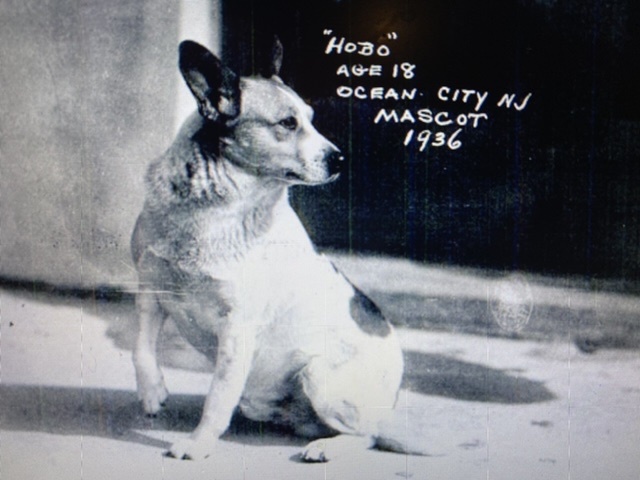A monument on the grounds of the Community Center at 1735 Simpson Ave. pays tribute to Hobo, "Ocean City's Beloved Mascot."
 By TIM KELLY
By TIM KELLY A monument on the grounds of the Community Center at 1735 Simpson Ave. pays tribute to Hobo, "Ocean City's Beloved Mascot."
Hobo was also known to rest on the Boardwalk, sunning himself next to the benches or accepting belly rubs from friends old and new.
During his lifetime, Hobo’s legend grew, as did he. With all the treats and meals being given out, the dog gained weight and his walk “became a waddle,” according to a published report.
The big appetite and generosity of his human buddies did not affect Hobo’s longevity. His life spanned all of the Roaring Twenties and most of the Great Depression.
As the town evolved from a sleepy beach community into a major tourism mecca, Hobo’s presence was a constant.
In Miller’s book “Ocean City: America’s Greatest Family Resort,” Hobo’s personality is described as being infectious to all, but particularly to children.
When the dog died on Dec. 8, 1936, children were said to have been the main contributors to a collection taken up for a monument. The $125 needed for a stone marker with Hobo’s likeness chiseled on the side was soon raised.
A local mortician donated a small casket and Hobo was laid to rest on the grounds of the original Ocean City High School.
The monument, a combination bird bath and dog drinking station, was installed at the graveside, where it stood for 29 years. Its inscription reads “In memory of ‘Hobo’ Ocean City’s Beloved Mascot. Died December 8, 1936, Aged 18 to 19 years.”
A construction project necessitated removal of the monument in 1965, where it was “lost” in a forgotten storage area until 1976. When re-discovered, the marker was installed at the former site of the Ocean City Historical Museum on Wesley Avenue.
The monument was moved once more to its present location in front of the Ocean City Community Center at 1735 Simpson Ave. when the Historical Museum moved there.
“Hobo made an impact on the community and he is fondly remembered,” Miller said. “Not many dogs achieve that kind of popularity.”
A monument on the grounds of the Community Center at 1735 Simpson Ave. pays tribute to Hobo, "Ocean City's Beloved Mascot."
Hobo was also known to rest on the Boardwalk, sunning himself next to the benches or accepting belly rubs from friends old and new.
During his lifetime, Hobo’s legend grew, as did he. With all the treats and meals being given out, the dog gained weight and his walk “became a waddle,” according to a published report.
The big appetite and generosity of his human buddies did not affect Hobo’s longevity. His life spanned all of the Roaring Twenties and most of the Great Depression.
As the town evolved from a sleepy beach community into a major tourism mecca, Hobo’s presence was a constant.
In Miller’s book “Ocean City: America’s Greatest Family Resort,” Hobo’s personality is described as being infectious to all, but particularly to children.
When the dog died on Dec. 8, 1936, children were said to have been the main contributors to a collection taken up for a monument. The $125 needed for a stone marker with Hobo’s likeness chiseled on the side was soon raised.
A local mortician donated a small casket and Hobo was laid to rest on the grounds of the original Ocean City High School.
The monument, a combination bird bath and dog drinking station, was installed at the graveside, where it stood for 29 years. Its inscription reads “In memory of ‘Hobo’ Ocean City’s Beloved Mascot. Died December 8, 1936, Aged 18 to 19 years.”
A construction project necessitated removal of the monument in 1965, where it was “lost” in a forgotten storage area until 1976. When re-discovered, the marker was installed at the former site of the Ocean City Historical Museum on Wesley Avenue.
The monument was moved once more to its present location in front of the Ocean City Community Center at 1735 Simpson Ave. when the Historical Museum moved there.
“Hobo made an impact on the community and he is fondly remembered,” Miller said. “Not many dogs achieve that kind of popularity.”